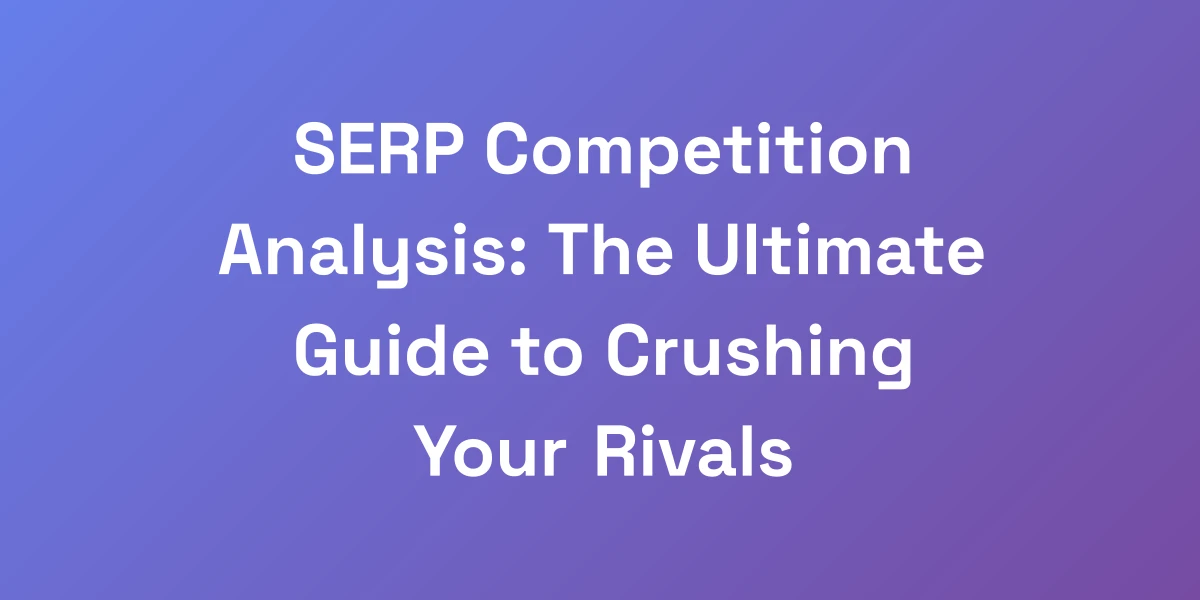
UX Competitive Analysis: 7 Brutal Ways to Crush Your Competition
Mar 13, 2025 | By [email protected]
Ever wondered why some brands seem to effortlessly dominate their market while others flounder despite having similar resources? It’s not just luck—it’s strategic competitive analysis in UX design.
We’re diving deep into the nitty-gritty of UX competitive analysis, where the top 1% aren’t just playing the game—they’re rewriting the rules. If you’ve been struggling to stand out or simply want to ensure you’re not leaving money on the table, you’re in the right place.
We’re going to break down the barriers, smash the conventional approaches, and lay out seven brutal ways that can propel your UX design from mediocre to market-dominating. Ready to leave your competition in the dust? Let’s get started.
Why Most UX Competitive Analysis Fails (And What It Really Takes to Win)
Let me hit you with some truth: 90% of UX designers are doing competitive analysis wrong. They’re playing checkers while the top 1% are playing chess. The difference? Winners understand that competitive analysis isn’t about copying features – it’s about identifying and exploiting gaps that your competitors are too blind to see. In this guide, we’re going to show you exactly how the elite players use competitive analysis to dominate their market and create experiences that make users forget your competition exists.
This often results from common competitive intelligence mistakes, such as misinterpreting data or overlooking critical user feedback.
The Real Cost of Poor Competitive Analysis
Imagine investing thousands into a UX design overhaul only to see minimal improvement. That’s the cost of poor competitive analysis. Without a solid understanding of what your competitors are doing right—or wrong—you’re essentially navigating in the dark.
- User Churn: Poor UX can drive users straight to your competitors.
- Lost Revenue: Each lost user is a potential sale slipping through your fingers.
- Brand Damage: Consistently bad experiences tarnish your brand’s reputation.
Doesn’t it make sense to avoid these pitfalls by getting your competitive analysis right from the start?
Breaking Down the Winner’s Framework
Winners don’t wing their competitive analysis—they follow a precise framework that ensures every angle is covered. Here’s what sets them apart:
- Comprehensive Benchmarking: They measure their UX against top competitors using clear metrics.
- Continuous Monitoring: They keep a pulse on competitor moves and market shifts.
- User-Centric Insights: They dive deep into user behaviors and preferences to inform their strategies.
By adopting this framework, you can ensure your competitive analysis is robust and actionable.
Setting Yourself Up for Domination
It’s not just about analyzing; it’s about setting the stage for dominance. Here’s how to prepare:
- Define Clear Objectives: What are you hoping to achieve? Increased conversions? Higher user satisfaction?
- Assemble the Right Team: Blend designers, analysts, and strategists to cover all bases.
- Secure the Necessary Tools: Invest in tools that provide detailed insights, not just surface-level data.
Preparation is key. Without it, even the best analysis can fall flat.
The Mindset Shift Required for Success
To truly crush your competition, you need to adopt a different mindset. Instead of seeing competitors as threats, view them as sources of valuable intelligence. Ask yourself:
- What are they doing right that we’re not?
- Where are their user experiences falling short?
- How can we leverage their weaknesses to our advantage?
This shift from reactive to proactive thinking is what transforms good UX design into exceptional, market-leading experiences.
The Strategic Foundation: Setting Up Your Competitive Analysis Framework
Before you even think about analyzing your competitors, you need to build a framework that actually produces results. Most people jump straight into tools and features, but that’s amateur hour. What you need is a systematic approach that combines data-driven insights with psychological triggers. Based on the latest UX research trends, we’re going to show you how to build a framework that doesn’t just collect information—it weaponizes it to create an unfair advantage in your market.
Identifying Your True Competitors (Not Who You Think)
First things first: not all competitors are created equal. You need to identify who truly poses a threat to your UX design goals.
- Direct Competitors: Those offering the same products or services.
- Indirect Competitors: Those offering alternatives that solve the same user problem.
- Emerging Competitors: New entrants that could disrupt your market.
By broadening your scope, you ensure no stone is left unturned in your competitive analysis.
Creating Your Analysis Scorecard
A scorecard is your roadmap. It outlines what you’re evaluating and how.
- Usability: How easy is the product to use?
- Feature Set: What functionalities are offered?
- Design Aesthetics: How visually appealing is the product?
- User Feedback: What are users saying about it?
Having a clear scorecard ensures consistency and comprehensiveness in your analysis.
Setting Clear Metrics for Success
Without metrics, you’re just guessing. Define what success looks like for your competitive analysis, utilizing key metrics like conversion rate optimization statistics and SEO optimization automation:
- Conversion Rates: Are competitors converting better?
- User Retention: How are users sticking around?
- Engagement Levels: Are users more engaged with competitors’ products?
These metrics will guide your strategy and help you measure progress accurately.
Tools That Actually Matter
Not all tools are created equal. Focus on ones that provide in-depth insights:
- UXtweak: Comprehensive usability testing and moderated studies.
- Maze: Remote usability testing and user research.
- Baymard: Detailed UX benchmarks for e-commerce.
Choosing the right tools can make or break your competitive analysis efforts. For comprehensive UX competitive analysis tools, Maze provides a robust suite.
If you’re considering auto SEO tools, these tools might be worth exploring.
Building Your Data Collection System
Data is only as good as the system you have for collecting it. Here’s how to set it up:
- Automate Where Possible: Use tools that can gather data continuously.
- Standardize Your Process: Ensure consistency in how data is collected and stored.
- Integrate Multiple Sources: Combine qualitative and quantitative data for a holistic view.
A robust data collection system ensures you have the information you need, when you need it.
Advanced UX Intelligence Gathering Techniques
Listen, anyone can use a heatmap tool or run a basic user test. But if you want to uncover the gold that your competitors are hiding, you need to go deeper. We’re talking about advanced intelligence gathering that reveals not just what users do, but why they do it. This is where you’ll find the opportunities that everyone else misses, and we’re going to show you exactly how to exploit them.
Psychological Trigger Mapping
Understanding the psychological triggers that influence user behavior is crucial. Here’s how to map them:
- Emotional Responses: Identify what emotions your competitor’s UX evokes.
- Motivational Drivers: What drives users to take action on competitor platforms?
- Decision-Making Processes: How do users make choices within the UX environment?
By mapping these triggers, you can design experiences that resonate more deeply with your users.
User Journey Deep Dives
Don’t just scratch the surface. Dive deep into the user journeys of your competitors.
- Identify Key Touchpoints: Where do users interact most with their product?
- Analyze Friction Points: Where are users dropping off or getting frustrated?
- Map Out Pain Points: Understand the specific issues users face during their journey.
Deep dives into user journeys reveal the true strengths and weaknesses of your competitors’ UX designs.
Conversion Path Analysis
Understanding how users navigate to conversion can provide a massive edge.
- Entrance Points: Where are users entering the funnel?
- Drop-Off Points: Identify where users abandon the process.
- Optimization Opportunities: Find areas to streamline the conversion path.
By analyzing these paths, you can optimize your own conversion funnels to outperform competitors.
Pain Point Mining
Every great UX improvement starts with identifying and addressing user pain points. Here’s how to mine for them:
- User Feedback: Collect and analyze feedback from competitor users.
- Usability Testing: Conduct tests focused on uncovering friction areas.
- Behavioral Data: Use analytics to see where users struggle the most.
Addressing these pain points in your UX can give you a significant advantage over your competition.
Competitive Edge Detection
What unique advantages do your competitors have? Detecting these edges is critical.
- Unique Features: Identify features that set competitors apart.
- Design Innovations: Look for innovative design elements that improve user experience.
- User Loyalty: Understand what keeps users coming back to their platform.
Understanding these edges allows you to either match them or find ways to surpass them, ensuring your UX stands out.
Turning Analysis Into Action: The Implementation Blueprint
Data without action is worthless. Period. What separates the winners from the losers is their ability to turn insights into immediate, profitable action. We’re going to give you our exact blueprint for taking everything you’ve learned and turning it into tangible improvements that users can’t resist. This isn’t theory—it’s the same process that’s generated millions in value for our clients.
Rapid Prototyping from Insights
Once you’ve gathered your insights, the next step is to rapidly prototype solutions.
- Brainstorm Solutions: Use your insights to brainstorm potential UX improvements.
- Create Wireframes: Quickly sketch out new designs based on your ideas.
- Iterate Fast: Develop prototypes quickly and iterate based on feedback.
The ability to move from insight to prototype swiftly ensures you capitalize on opportunities before your competitors even realize them.
Testing and Validation Frameworks
Ideas are only as good as their effectiveness. Here’s how to validate your prototypes:
- Usability Testing: Test your prototypes with real users to gather feedback.
- A/B Testing: Compare different versions to see which performs better.
- Analytics Review: Use data to validate the impact of your changes.
Testing and validation ensure that your actions are based on solid evidence, not just assumptions.
Implementation Prioritization Matrix
Not all improvements can be tackled at once. Use a prioritization matrix to decide:
- High Impact, Low Effort: Prioritize these for quick wins.
- High Impact, High Effort: Plan these strategically; they’re essential for long-term success.
- Low Impact, Low Effort: Tackle these as fillers when resources allow.
This structured approach ensures you’re always working on the most valuable improvements first.
Measuring Impact and ROI
After implementation, measuring the impact is crucial to understand your return on investment:
- Track Key Metrics: Monitor metrics like conversion rate, user retention, and engagement.
- User Feedback: Continuously gather feedback to assess user satisfaction.
- Performance Dashboards: Use dashboards to visualize the impact of your changes in real-time.
By rigorously measuring impact, you ensure that every action you take contributes to your overall goals.
Scaling What Works
When you find something that works, don’t stop there. Here’s how to scale effectively:
- Standardize Processes: Develop standard operating procedures for successful UX practices.
- Automate Where Possible: Use automation tools to maintain consistency and efficiency.
- Expand Across Platforms: Apply successful strategies to all your digital touchpoints.
Scaling ensures that your winning strategies have a far-reaching impact, solidifying your market dominance.
Conclusion
We’ve navigated through the brutal yet essential strategies to leverage competitive analysis in UX design for market dominance. By understanding why most analyses fail and embracing a winner’s framework, you set the stage for success.
Implementing advanced intelligence gathering techniques and turning analysis into actionable plans ensure you’re not just keeping up—you’re leading the charge. Remember, it’s about identifying gaps, exploiting weaknesses, and continuously refining your approach.
Ready to crush your competition? Start by building a robust competitive analysis framework, dive deep into user insights, and relentlessly implement and scale what works. Your journey to market dominance begins now.
What’s the first step you’re going to take to elevate your UX competitive analysis? Let us know in the comments below or reach out to discuss how we can help you dominate your market.








